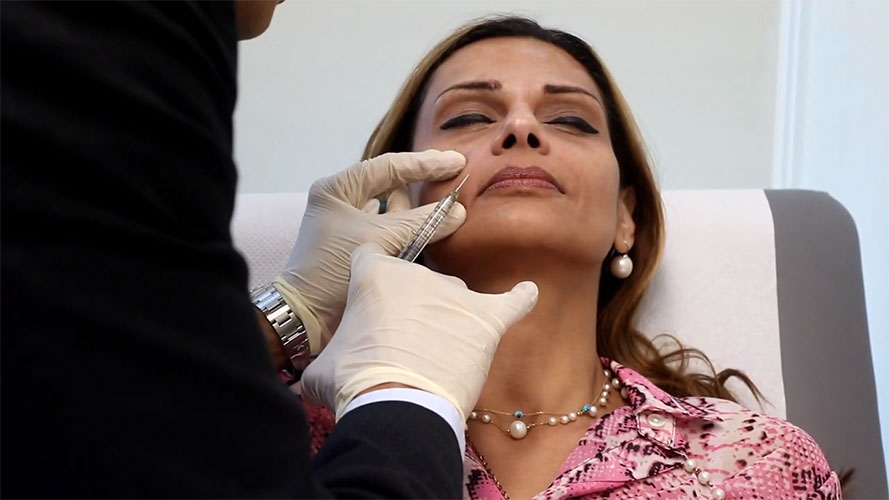Botulinum toxin is a chemical produced by the botulinum bacteria. Botulinum toxin is a protein derivative of the toxin, which, when injected to the muscle, causes it to become weakened or inactivated. It stops the muscle from functioning by blocking neuromuscular transmission – i.e. it stops the chemical messages from the nerve to the muscle.

By using facial muscles repeatedly throughout a lifetime, the skin is creased in areas of greatest use. The aging process causes the slow down of collagen end elastin production in the skin so that as we get older, these areas of over-use become damaged and the lines become permanent. By reducing the movement of muscles in these areas, the skin stops being creased and is allowed to recover, causing the lines to soften or even fade away. In the areas treated, the muscles are temporarily inactivated (always reversible), during which time the patient can break the subconscious habit of overusing these muscles. Depending on each individual and the dose used, the response to treatment can vary from a relaxation of the muscles to an inability to move the muscles. For the first couple of years, frequent treatments are required to ‘re-educate’ the facial muscles. Thereafter, treatments would be less frequent until a yearly maintenance treatment is normally all that is required.
As long ago as 1978, botulinum toxin was used as a treatment for patients with eye squints by weakening the over active eye muscle. Since then, it has been used in a variety of therapeutic areas such as spasmodic neck, writer’s cramp, tics, multiple sclerosis, facial spasm, Parkinson’s Disease and cerebral palsy, to name but a few. In more recent times the use of botulinum toxin for cosmetic therapy has become more widespread.
In high concentrations botulinum toxin is a potent poison. However, botulinum toxin used in minute doses, as it is in cosmetic therapy, has a very high margin of safety.
Mr Saour will discuss all the risks with you during your consultation.
The procedure takes about 5-10 minutes. The practitioner will ask you to use certain muscles of the face to observe how they work. An extremely fine, short needle is used to inject the botulinum toxin into the appropriate area. This may cause some slight but brief discomfort. The area may have some slight redness and swelling, which normally resolves in an hour or two. After treatment, you should not massage the injected area. You should not lie down for four hours after treatment. The treatment normally starts to take effect after 4 to 14 days, but this may vary slightly with some individuals. The effects will normally last between 2 and 6 months, when you will start to notice an ability to move the muscles more freely.
Side effects of this treatment are rare. Most people find that the injection causes only mild discomfort. Immediately after the injection there may be mild swelling, which usually subsides in 48 hours. Occasionally, a temporary drooping of the eyelid can occur. This may last a few weeks, but will always resolve. Special eye drops can be prescribed during this time to help lift the lid back into the normal position. In extremely rare cases patients have developed an allergy to the treatment, while others have shown resistance, i.e. it causes little or no effect on the treated muscles. If you are pregnant or a nursing mother, treatment is not recommended.
By using facial muscles repeatedly throughout a lifetime, the skin is creased in areas of greatest use. The aging process causes the slow down of collagen end elastin production in the skin so that as we get older, these areas of over-use become damaged and the lines become permanent. By reducing the movement of muscles in these areas, the skin stops being creased and is allowed to recover, causing the lines to soften or even fade away. In the areas treated, the muscles are temporarily inactivated (always reversible), during which time the patient can break the subconscious habit of overusing these muscles. Depending on each individual and the dose used, the response to treatment can vary from a relaxation of the muscles to an inability to move the muscles. For the first couple of years, frequent treatments are required to ‘re-educate’ the facial muscles. Thereafter, treatments would be less frequent until a yearly maintenance treatment is normally all that is required.
As long ago as 1978, botulinum toxin was used as a treatment for patients with eye squints by weakening the over active eye muscle. Since then, it has been used in a variety of therapeutic areas such as spasmodic neck, writer’s cramp, tics, multiple sclerosis, facial spasm, Parkinson’s Disease and cerebral palsy, to name but a few. In more recent times the use of botulinum toxin for cosmetic therapy has become more widespread.
In high concentrations botulinum toxin is a potent poison. However, botulinum toxin used in minute doses, as it is in cosmetic therapy, has a very high margin of safety.
Mr Saour will discuss all the risks with you during your consultation.
The procedure takes about 5-10 minutes. The practitioner will ask you to use certain muscles of the face to observe how they work. An extremely fine, short needle is used to inject the botulinum toxin into the appropriate area. This may cause some slight but brief discomfort. The area may have some slight redness and swelling, which normally resolves in an hour or two. After treatment, you should not massage the injected area. You should not lie down for four hours after treatment. The treatment normally starts to take effect after 4 to 14 days, but this may vary slightly with some individuals. The effects will normally last between 2 and 6 months, when you will start to notice an ability to move the muscles more freely.
Side effects of this treatment are rare. Most people find that the injection causes only mild discomfort. Immediately after the injection there may be mild swelling, which usually subsides in 48 hours.Occasionally, a temporary drooping of the eyelid can occur. This may last a few weeks, but will always resolve. Special eye drops can be prescribed during this time to help lift the lid back into the normal position. In extremely rare cases patients have developed an allergy to the treatment, while others have shown resistance, i.e. it causes little or no effect on the treated muscles. If you are pregnant or a nursing mother, treatment is not recommended.
Once you have decided you are interested in cosmetic surgery
Mr Saour’s aim is to help you look and feel your best through high quality personalised care.
You will receive all the information preoperatively allowing you to make an informed decision.
Understanding the benefits, implications and potential risks of any type of surgery is of paramount importance.

Internationally recognised
proud to be part of :



